Traditionally, large-sized furniture modules are used for kitchen furniture, however, in recent years, more and more users prefer hanging shelves instead of bulky upper cabinets. This solution makes the kitchen brighter, more spacious and stylish. Let us dwell on the pros and cons of shelves, their varieties, design and subtleties of choice.






Advantages and disadvantages
Wall shelves are considered the best solution for storing tableware, kitchen utensils, cereals, spices and other products. Among the main advantages of such structures, the following factors can be noted.
- Practicality. They take up very little space, visually expand the room, make it much brighter and more voluminous. In addition, open shelves allow you to quickly find any desired item.
- Multifunctionality. On the shelves you can always mark both kitchen items and decorative elements, for example, flowerpots with flowers, flowerpots with indoor plants, figurines and even cookbooks. Such designs are not only part of the storage system, but also an element of the interior.
- Big choice. Shelves are available in a wide range of types; for their production, wood, plastic, metal, glass and other materials are used. They can have a variety of sizes, shapes and designs, which is why everyone can choose for themselves the option that will best meet the ideas of the owners of the room about functionality and at the same time correspond to the style of the room.
- Ergonomics Open wall shelves can be hung at any height, often they serve as a link between the hanging cabinets. Unlike models whose doors have to be constantly opened and closed, shelves are more convenient to use. They are also easy to clean.
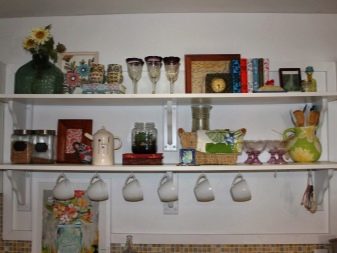



At the same time, one cannot fail to note some drawbacks, which for many housewives become an occasion for rejecting the idea of using such structures.
The capacity of the shelves is much less than that of the cabinets. For example, it is unlikely that it will be possible to place large pots, pans, cast-iron and other elements of kitchen utensils.


Shelves are open for review, they attract attention, so you have to think carefully about the details of placing objects on them. So, not everyone can like the dishes displayed at the show, food packages and kitchen utensils.
The contents of the shelves are quickly contaminated with dust, so cleaning has to be done more often.
In addition, with open shelves, any defects in repair and cleanliness are immediately evident, which significantly impairs the aesthetics of the kitchen as a whole.
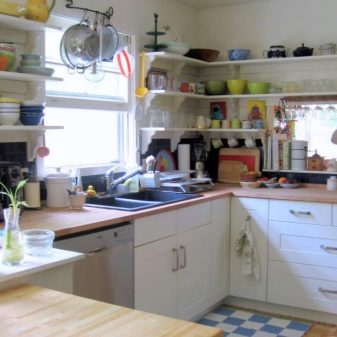

Types of designs
Depending on the design features, several types of wall shelves are distinguished.
- Open. Such products can be classified as decorative and functional, they provide quick access to dishes and make it possible to organize the storage of many items needed in the kitchen without creating clutter with cabinets.
At the same time, such designs impose rather stringent requirements on stored items in terms of size, shape, type and material of production.


- Closed. These models have rear and side walls, and are also equipped with doors (they can be hinged, sliding or lifting). As a rule, closed structures are optimal for storing sharply smelling spices, fragile items, cereals and other bulk products.

- Corner shelves. These devices are optimal for small rooms. They are compact and ergonomic, therefore they are used with maximum rationality, especially in confined spaces. Usually they are hung in the corner above the countertop or near the corner sofa.
Most often they use multi-level shelves, which allow you to place a large number of a wide variety of kitchen utensils.


- Lattice shelves. These products are produced in a wide variety of designs; they differ in shape, dimensions and color scheme. Such designs are able to withstand quite noticeable weight loads, which makes them very convenient for storing tableware.

- Shelves with built-in drawers. These designs are as close as possible to traditional kitchen cabinets, but they do not clutter up the space and do not interfere with the spread of light, and therefore contribute to the visual expansion of the kitchen and a more comfortable stay in it.
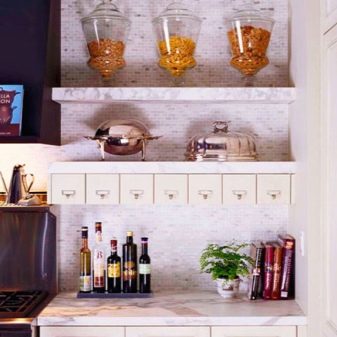

- Shelves with backlight. This is a very interesting stylish solution, besides quite practical. Such shelves can become an independent source of light, usually LED strips, spotlights or small sconces are built into them.
As a rule, the back wall of such structures is made of a mirror, due to which the light is scattered and creates an atmosphere of mystery and comfort.


Materials of manufacture
For the manufacture of wall shelves, different materials and their combinations are used, while each of them has its own advantages and disadvantages.
The most common solution are shelves made of laminated particleboard. This is a cheap material that is easy to shape and assemble - the boards are easily cut with a circulation saw, so when making shelves you can realize the most unusual fantasies and design ideas. Products can be of any shape, from standard rectangular to radius. At the same time, this material is considered less durable than all others.

Metal products usually have a rather elegant configuration. Due to the increased strength characteristics of the metal, such devices can withstand significant loads, they are extremely practical and durable. Metal fits best into kitchen interiors decorated in hi-tech or modern style, chrome grilles give the product sophistication and sophistication, emphasize the impeccable taste and high income of the owners of the room.
Metal shelves look best in a kitchen where objects with metal and glass surfaces are already installed.
Please note that when buying, it is necessary to give preference to materials resistant to corrosion, otherwise the appearance of a rusted shelf is unlikely to decorate your interior.


Wooden is the most common solution. Wood is considered an environmentally friendly material, and in addition, it allows you to fill the kitchen with a feeling of warmth and family comfort. Wooden shelves are often decorated with carved openwork elements, so they harmoniously fit into traditional classic interiors, for example, country and Provence. The tree looks especially impressive in combination with elements of the style of shabby chic and eco-style.
However, one should not forget that under the influence of enemies, the wood swells greatly, so you should not use such items to dry dishes that have just been washed. It is also not recommended to place flower pots on them.


Plastic - these products are classified as economy class. Plastic is resistant to moisture, because such devices will be indispensable for drying kitchen utensils. In addition, plastic shelves in a wide variety of color palettes are on sale, so everyone can choose the best option for their kitchen. Plastic has a low weight, it is easy to clean, but it can deform under the influence of heat, so you should keep such shelves away from the stove.


Glass wall shelves at first glance seem fragile, but in fact this is not so - they are made using not ordinary, but specially tempered glass with a thickness of at least 6 mm, it can withstand quite impressive loads.
As a rule, the installation of such shelves is carried out using special hidden fasteners, which creates the feeling that the structures seem to hang in the air.

Stone shelves - such a solution in the interior is extremely rare, since the stone has a significant weight, which creates an increased load on the walls and fastenings. Of course, a shelf of marble or granite has a decorative, expensive and impeccable appearance, which immediately attracts attention, but with insufficient quality of installation, the probability of falling of such structures is high, and they are very expensive.

How to choose?
If you are determined to abandon standard kitchen cabinets in favor of shelves, it is important to make the right choice. First of all, you should decide on the purpose of your purchase: what function will the construction in the kitchen fulfill, what products do you intend to place on it and what will be the approximate weight load.
- Be sure to consider the size of the room and the stylistic design of the interior. So, for small kitchens, narrow shelves that do not burden the perception of the room will be the best choice, and for spacious kitchens you can choose more massive wide models.
- The appearance of the shelf must certainly be in harmony with the design of the remaining items in the kitchen.
- If you have a certain choice, it is better to give preference to models with hanging fasteners - you can dismantle this shelf at any time in order to wash it and clean it from dirt.
- When choosing options, it is better to purchase a narrow multi-level shelf instead of a wide single-level shelf - such a design will allow you to place a large number of the most diverse items.


Use in the interior
Shelves become not only a functional part of the storage system for kitchen items, but also an element of decor, which can either emphasize the design concept, or nullify all efforts to design the interior. That is why when choosing shelves should take into account the general idea of decorating the kitchen.
So, classic style and provence go well with open wooden shelves. And if you make them artificially aged or carved, they will fit well into the style of shabby chic. Shelves decorated with original floral ornaments will help to place the necessary accents in the interiors of country or eco style.

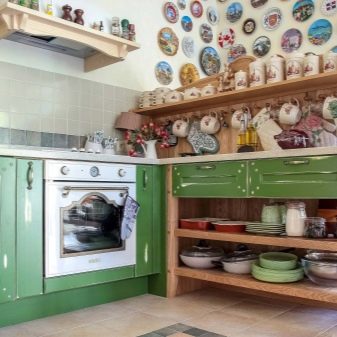
Fans of hi-tech and modern can be advised products made of ferrous metal or glass. Such surfaces in tandem with chrome elements will give the kitchen furniture some mystery and even a slight feeling of being on an alien space object. Breakfasts, lunches and dinners in such a room will invariably be perceived as part of a fantastic adventure.
As a rule, such shelves are mounted to the walls, but some manufacturers have launched the release of shelves for railing, they are characterized by compact dimensions and ease of placement on the support.
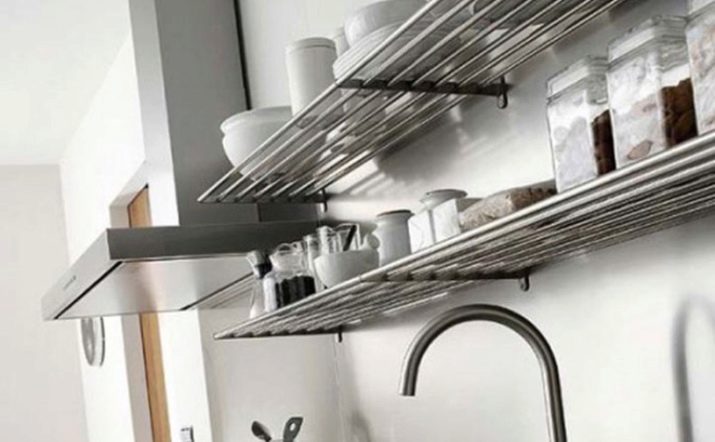
For supporters of ultra-modern interiors, as well as lovers of mixing styles, shelves with different types of lighting can be recommended. In addition to a spectacular appearance, they will create additional lighting for the work area.

See how to make a shelf in the kitchen with your own hands in the next video.










